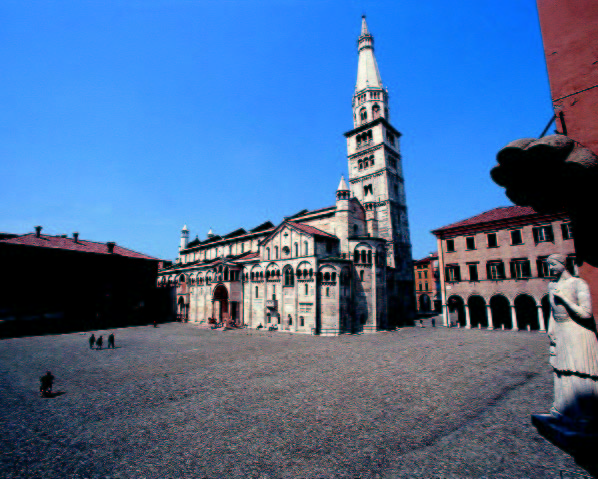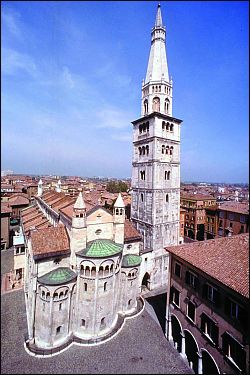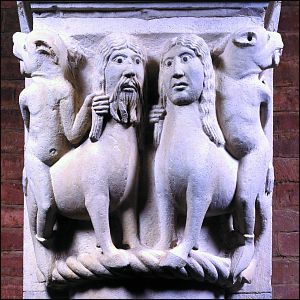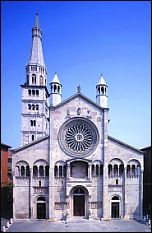

duomo e ghirlandina Anna
Lisa Bondioli (modena) |
 |
Nel 1099, durante la “lotta per le investiture”, quando i contrasti fra l’Impero e il Papato privarono Modena della cattedra vescovile, fu iniziata la costruzione della cattedrale romanica per accogliere la tomba di San Geminiano. Immagine dell’aspirazione all’autogoverno della città, essa fu consacrata nel 1184 alla presenza di Papa Lucio III. L’architetto fu Lanfranco, affiancato dallo scultore Wiligelmo, a cui si avvicendarono le maestranze campionesi che edificarono anche la Ghirlandina. Tra Ottocento e Novecento la chiesa e la torre furono oggetto di una vasta campagna di restauro finalizzata al recupero dell’assetto originario degli edifici. Alcune demolizioni isolarono i corpi di fabbrica, mentre l’interno del Duomo fu spogliato di altari e decorazioni aggiunte nel corso dei secoli. Furono anche ripristinati il pontile e l’ambone campionesi, le cui lastre erano state rimosse a fine Cinquecento. |
The building of the Romanesque cathedral started in 1099 during the “fight for investitures”, when the conflicts between the Empire and the Papacy divested Modena of its Episcopal See, to host the grave of San Geminiano. A symbol of the aspiration of the town towards self-government, it was consecrated in 1184, at the presence of Pope Lucius III. The architect was Lanfranco, supported by sculptor Wiligelmo, whose work was then taken over by the Campione builders, who erected also the Ghirlandina tower. Between the 19th and 20th centuries, were both the church and the tower submitted to an extensive restoration campaign aimed at resuming the original aspect of the buildings. Some demolitions isolated the main bodies, and the interior of the cathedral was stripped of altars and decorations added throughout the centuries. Also the Campione stage and ambo, whose slabs had been removed in the late 16th century, were resumed. |
|
DUOMO
e GHIRLANDINA http://www.comune.modena.it/gioarte/iniziative/geminemuse/2004/ |
 |
Torre
Ghirlandina, |
Iniziata con la cattedrale e terminata nel 1319 da Arrigo da Campione, la torre deve probabilmente il suo nome alle “ghirlande” di loggette e balaustri che circondavano la cuspide. La sua funzione fu civile e religiosa: le sue stanze ospitarono gli archivi comunale e capitolare, l’argenteria e le reliquie del Duomo nonché la famosa Secchia trafugata ai bolognesi nella battaglia di Zappolino (1325). Più volte restaurata, fu spogliata degli ornati gotici e sopraelevata nella guglia alla fine del Cinquecento. A quella data risale anche la trasformazione in belvedere della stanza del quinto piano dove, dal 1306, risiedevano i “torresani”, custodi incaricati di sorvegliare la città e di segnalare le ore. Started with the cathedral and completed by Arrigo da Campione in 1319, the tower most likely owes its name to the “garlands” of small loggias and balusters surrounding the pinnacle. Its function was both civil and religious: its rooms hosted the municipal and capitular archives, the cathedral silverware and relics, as well as the famous Pail stolen to Bologna at the battle of Zappolino (1325). Restored several times, it was stripped of the gothic ornaments and risen in the pinnacle at the end of the 16th century. The room at the fifth floor, which had been occupied by the “torresani” (the guards whose task was watching the town and announce the hours) since 1306, was turned into a belvedere at that same date. |
| Anna
Lisa Bondioli Nata a / Born in Mirandola (MO), 1975 Vive e lavora a / She lives and works in San Felice sul Panaro (MO) anna.bond@tiscali.it |
Cervia
76 , 2004 |
L’intervento
dell’artista riflette sulla dimensione simbolica assunta dalla Ghirlandina
nel corso dei secoli. Con l’avvento della fotografia e soprattutto
con il suo impiego nelle cartoline postali, questa torre campanaria ha
avuto la responsabilità e l’onore di rappresentare la città
di Modena più di ogni altro monumento cittadino.
The work of the artist is a reflection on the symbolic
dimension taken by the Ghirlandina Luca Panaro |
|
 |
Wiligelmo,
Capitello della terza colonna del fianco sud con esseri mostruosi, |
Due mostri dalle sembianze umane, ma con la testa di cane, cavalcano creature ispirate a centauri di classica memoria, volgendo il capo indietro a mordere una foglia. La critica più recente riconosce la mano di Wiligelmo anche nelle prime arcate del fianco sud dove, come nella facciata, si evidenziano quegli aspetti immaginari e mostruosi così frequenti nel mondo medievale. Tuttavia, nell’esuberanza fantastica che rende ogni mensola e ogni capitello un capo d’opera, unico nella sua prodigiosa ricchezza inventiva, il genio di Wiligelmo seppe conservare il ricordo di un passato classico. Two monsters of human features, but with a dog head, ride creatures inspired to centaurs of classical memory while turning their heads backwards to bite a leaf. The most recent researches recognise Wiligelmo’s hand in the façade and also in the first arches of the South side where those imaginary, monstrous aspects, so frequent in the medieval world, are highlighted. Nevertheless, in the fantastic exuberance which makes a masterpiece of every corbel and capital, Wiligelmo’s genius, unique in its prodigious inventive richness, managed to preserve the memory of a classic past. |
| Luca
Lumaca Nato a / Born in Modena, 1978 Vive e lavora a / He lives and works in Modena lucalumaca@tiscalinet.it |
Allegory,
2004 |
Nel
Duomo di Modena l’artista si è imbattuto in una interessante
raffigurazione di un capitello. Si In Modena’s cathedral, did the artist come across an interesting representation of a capital: a couple of Centaurs subdued by two Cerberus. This subject is frequently dealt with in the medieval culture to report the victory of gods’ power (whose messengers where the dog-men) on knowledge (represented by the horse-men). Luca Lumaca recovers the core teaching of this bas-relief by updating it to our days and showing with regret that history is cyclic and thus repeats: today as in the past ages the power groups do not want the people to acquire autonomous means of reading and interpreting reality. Mass media are instruments of control and domination, which have tried to affect our free will since childhood. Luca Panaro |
|
 |
Facciata
del / Façade of Duomo di Modena |
Wiligelmo fu probabilmente il “regista” della facciata, colui che seppe arricchire di straordinario valore scultoreo il progetto architettonico di Lanfranco. I valori plastici di Wiligelmo, perfettamente interpretati dagli allievi e dai Maestri Campionesi che proseguirono la sua opera, integrano e arricchiscono l’originaria impostazione della facciata lanfranchiana, che rivela immediatamente la struttura dell’edificio, a tre navate originariamente coperte da capriate lignee. Il tema della lotta tra l’uomo e il peccato si impone mediante la capacità narrativa e la forza espressiva delle lastre scolpite, inserite con coerenza nello spazio scandito dai tre pilastri e segnato dal protiro, dalla loggia e dal rosone gotico di Alfonso da Campione. Wiligelmo was most likely the “supervisor” of the façade, the one who enriched Lanfranco’s architectural project with an extraordinary sculptural value. Wiligelmo’s plastic values, which were perfectly interpreted by his pupils and by the Campione Masters who pursued his work, integrate and enrich the original set up of Lanfranco’s façade, which immediately reveals the structure of the building, whose nave and two aisles were originally covered by wooden trusses. The theme of man’s fight against sin stands out in the narrative capacity and expressive strength of the sculpted slabs, which are coherently inserted in the space, articulated by the three pillars and marked by the entrance arch, loggia and gothic rose window made by Alfonso da Campione. |
| Silvia
Ferri Nata a / Born in Padova, 1971 Vive e lavora a / She lives and works in Padova ferrisil@tiscalinet.it |
Modenesi
in esposizione, 2004 |
Quando
si pensa al Duomo di Modena la prima immagine che salta alla mente è
la sua splendida When one thinks about Modena’s cathedral, the first image that comes to mind is its splendid façade. Invited to intervene on the monument of a town she is not familiar with, Silvia Ferri has just selected the most known side of the building, laying her condition of tourist onto Modena citizens. In her work, the local inhabitants, used to pass quite often under their own cathedral, suddenly found themselves plunged into the consuetude of the occasional visitor. Some of them used the camera the artist made available to them with the intent of observing details they never saw before; others posed in the way tourists are used to do when they want to record their presence beside a monument that is unlikely to see again. Luca Panaro |
|